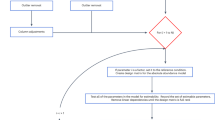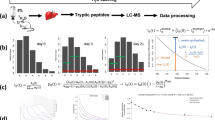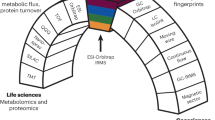Abstract
The recent development of metaproteomics has enabled the direct identification and quantification of expressed proteins from microbial communities in situ, without the need for microbial enrichment. This became possible by (1) significant increases in quality and quantity of metagenome data and by improvements of (2) accuracy and (3) sensitivity of modern mass spectrometers (MS). The identification of physiologically relevant enzymes can help to understand the role of specific species within a community or an ecological niche. Beside identification, relative and absolute quantitation is also crucial. We will review label-free and label-based methods of quantitation in MS-based proteome analysis and the contribution of quantitative proteome data to microbial ecology. Additionally, approaches of protein-based stable isotope probing (protein-SIP) for deciphering community structures are reviewed. Information on the species-specific metabolic activity can be obtained when substrates or nutrients are labeled with stable isotopes in a protein-SIP approach. The stable isotopes (13C, 15N, 36S) are incorporated into proteins and the rate of incorporation can be used for assessing the metabolic activity of the corresponding species. We will focus on the relevance of the metabolic and phylogenetic information retrieved with protein-SIP studies and for detecting and quantifying the carbon flux within microbial consortia. Furthermore, the combination of protein-SIP with established tools in microbial ecology such as other stable isotope probing techniques are discussed.
Similar content being viewed by others
Log in or create a free account to read this content
Gain free access to this article, as well as selected content from this journal and more on nature.com
or
References
Bastida F, Rosell M, Franchini AG, Seifert J, Finsterbusch S, Jehmlich N et al (2010). Elucidating MTBE degradation in a mixed consortium using a multidisciplinary approach. FEMS Microbiol Ecol 73: 370–384.
Belnap CP, Pan C, Denef VJ, Samatova NF, Hettich RL, Banfield JF . (2011). Quantitative proteomic analyses of the response of acidophilic microbial communities to different pH conditions. ISMEJ 5: 1152–1161.
Belnap CP, Pan C, VerBerkmoes NC, Power ME, Samatova NF, Carver RL et al (2010). Cultivation and quantitative proteomic analyses of acidophilic microbial communities. ISMEJ 4: 520–530.
Beynon RJ, Pratt JM . (2005). Metabolic labeling of proteins for proteomics. Mol Cell Proteomics 4: 857–872.
Bozinovski D, Herrmann S, Richnow HH, von Bergen M, Seifert J, Vogt C . (2012). Functional analysis of an anaerobic m-xylene-degrading enrichment culture using protein-based stable isotope probing. FEMS Microbiol Ecol 81: 134–144.
Callister SJ, Wilkins MJ, Nicora CD, Williams KH, Banfield JF, Verberkmoes NC et al (2010). Analysis of biostimulated microbial communities from two field experiments reveals temporal and spatial differences in proteome profiles. Environ Sci Technol 44: 8897–8903.
Cantarel BL, Erickson AR, VerBerkmoes NC, Erickson BK, Carey PA, Pan C et al (2011). Strategies for metagenomic-guided whole-community proteomics of complex microbial environments. PLoS ONE 6: e27173.
Delmotte N, Knief C, Chaffron S, Innerebner G, Roschitzki B, Schlapbach R et al (2009). Community proteogenomics reveals insights into the physiology of phyllosphere bacteria. Proc Natl Acad Sci USA 106: 16428–16433.
Denef VJ, Kalnejais LH, Mueller RS, Wilmes P, Baker BJ, Thomas BC et al (2010). Proteogenomic basis for ecological divergence of closely related bacteria in natural acidophilic microbial communities. Proc Natl Acad Sci USA 107: 2383–2390.
Erickson AR, Cantarel BL, Lamendella R, Darzi Y, Mongodin EF, Pan C et al (2012). Integrated metagenomics/metaproteomics reveals human host-microbiota signatures of Crohn’s disease. PLoS ONE 7: e49138.
Ferrer M, Ruiz A, Lanza F, Haange SB, Oberbach A, Till H et al (2013). Microbiota from the distal guts of lean and obese adolescents exhibit partial functional redundancy besides clear differences in community structure. Environ Microbiol 15: 211–226.
Fetzer I, Jehmlich N, Vogt C, Richnow HH, Seifert J, Harms H et al (2010). Calculation of partial isotope incorporation into peptides measured by mass spectrometry. BMC Res Notes 3: 178.
Guazzaroni ME, Herbst FA, Lores I, Tamames J, Pelaez AI, Lopez-Cortes N et al (2013). Metaproteogenomic insights beyond bacterial response to naphthalene exposure and bio-stimulation. ISMEJ 7: 122–136.
Haange SB, Oberbach A, Schlichting N, Hugenholtz F, Smidt H, von Bergen M et al (2012). Metaproteome analysis and molecular genetics of rat intestinal microbiota reveals section and localization resolved species distribution and enzymatic functionalities. J Proteome Res 11: 5406–5417.
Huang WE, Stoecker K, Griffiths R, Newbold L, Daims H, Whiteley AS et al (2007). Raman-FISH: combining stable-isotope Raman spectroscopy and fluorescence in situ hybridization for the single cell analysis of identity and function. Environ Microbiol 9: 1878–1889.
Jechalke S, Franchini AG, Bastida F, Bombach P, Rosell M, Seifert J et al (2013). Analysis of structure, function and activity of a benzene degrading microbial community. FEMS Microbiol Ecol (doi:10.1111/1574-6941.12090).
Jehmlich N, Fetzer I, Seifert J, Mattow J, Vogt C, Harms H et al (2010). Decimal place slope, a fast and precise method for quantifying 13C incorporation levels for detecting the metabolic activity of microbial species. Mol Cell Proteomics 9: 1221–1227.
Jehmlich N, Kopinke FD, Lenhard S, Herbst FA, Seifert J, Lissner U et al (2012). Sulphur-36S stable isotope labeling of amino acids for quantification (SULAQ). Proteomics 12: 37–42.
Jehmlich N, Schmidt F, Hartwich M, von Bergen M, Richnow HH, Vogt C . (2008a). Incorporation of carbon and nitrogen atoms into proteins measured by protein-based stable isotope probing (Protein-SIP). Rapid Commun Mass Spectrom 22: 2889–2897.
Jehmlich N, Schmidt F, von Bergen M, Richnow HH, Vogt C . (2008b). Protein-based stable isotope probing (Protein-SIP) reveals active species within anoxic mixed cultures. ISMEJ 2: 1122–1133.
Jiao Y, D’Haeseleer P, Dill BD, Shah M, Verberkmoes NC, Hettich RL et al (2011). Identification of biofilm matrix-associated proteins from an Acid mine drainage microbial community. Appl Environ Microbiol 77: 5230–5237.
Keiblinger KM, Wilharititz IC, Schneider T, Roschitzki B, Schmid E, Eberl L et al (2012). Soil metaproteomics—Comparative evaluation of protein extraction protocols. Soil Biol Biochem 54: 14–24.
Keller M, Hettich R . (2009). Environmental proteomics: a paradigm shift in characterizing microbial activities at the molecular level. Microbiol Mol Biol Rev 73: 62–70.
Kermer R, Hedrich S, Taubert M, Baumann S, Schlömann M, Johnson DB et al (2012). Elucidation of carbon transfer in a mixed culture of Acidiphilium cryptum and Acidithiobacillus ferrooxidans using protein-based stable isotope probing. JIOMICS 2: 37–45.
Klaassens ES, de Vos WM, Vaughan EE . (2007). Metaproteomics approach to study the functionality of the microbiota in the human infant gastrointestinal tract. Appl Environ Microbiol 73: 1388–1392.
Larance M, Bailly AP, Pourkarimi E, Hay RT, Buchanan G, Coulthurst S et al (2011). Stable-isotope labeling with amino acids in nematodes. Nat Methods 8: 849–851.
Lauro FM, DeMaere MZ, Yau S, Brown MV, Ng C, Wilkins D et al (2011). An integrative study of a meromictic lake ecosystem in Antarctica. ISMEJ 5: 879–895.
Li X, LeBlanc J, Truong A, Vuthoori R, Chen SS, Lustgarten JL et al (2011). A metaproteomic approach to study human-microbial ecosystems at the mucosal luminal interface. PLoS ONE 6: e26542.
Liu H, Sadygov RG, Yates JR 3rd . (2004). A model for random sampling and estimation of relative protein abundance in shotgun proteomics. Anal Chem 76: 4193–41201.
Manefield M, Whiteley AS, Ostle N, Ineson P, Bailey MJ . (2002). Technical considerations for RNA-based stable isotope probing: an approach to associating microbial diversity with microbial community function. Rapid Commun Mass Spectrom 16: 2179–2183.
Mayali X, Weber PK, Brodie EL, Mabery S, Hoeprich PD, Pett-Ridge J . (2012). High-throughput isotopic analysis of RNA microarrays to quantify microbial resource use. ISMEJ 6: 1210–1221.
Morris BEL, Herbst FA, Bastida F, Seifert J, von Bergen M, Richnow HH et al (2012). Microbial interactions during residual oil and n-fatty acid metabolism by a methanogenic consortium. Environ Microbiol Rep 4: 297–306.
Morris RM, Nunn BL, Frazar C, Goodlett DR, Ting YS, Rocap G . (2010). Comparative metaproteomics reveals ocean-scale shifts in microbial nutrient utilization and energy transduction. ISMEJ 4: 673–685.
Mueller RS, Denef VJ, Kalnejais LH, Suttle KB, Thomas BC, Wilmes P et al (2010). Ecological distribution and population physiology defined by proteomics in a natural microbial community. Mol Syst Biol 6: 374.
Mueller RS, Dill BD, Pan C, Belnap CP, Thomas BC, Verberkmoes NC et al (2011). Proteome changes in the initial bacterial colonist during ecological succession in an acid mine drainage biofilm community. Environ Microbiol 13: 2279–2292.
Musat N, Foster R, Vagner T, Adam B, Kuypers MMM . (2012). Detecting metabolic activities in single cells, with emphasis on nanoSIMS. FEMS Microbiol Rev 36: 486–511.
Neilson KA, Ali NA, Muralidharan S, Mirzaei M, Mariani M, Assadourian G et al (2011). Less label, more free: approaches in label-free quantitative mass spectrometry. Proteomics 11: 535–553.
Old WM, Meyer-Arendt K, Aveline-Wolf L, Pierce KG, Mendoza A, Sevinsky JR et al (2005). Comparison of label-free methods for quantifying human proteins by shotgun proteomics. Mol Cell Proteomics 4: 1487–1502.
Ong SE, Foster LJ, Mann M . (2003). Mass spectrometric-based approaches in quantitative proteomics. Methods 29: 124–130.
Ong SE, Mann M . (2005). Mass spectrometry-based proteomics turns quantitative. Nat Chem Biol 1: 252–262.
Pan C, Fischer CR, Hyatt D, Bowen BP, Hettich RL, Banfield JF . (2011). Quantitative tracking of isotope flows in proteomes of microbial communities. Mol Cell Proteomics 10: 006049.
Peréz-Cobas AE, Gosalbes MJ, Friedrichs A, Knecht H, Artacho A, Eismann K et al (2012). Gut microbiota disturbance during antibiotic therapy: a multi-omic approach. Gut doi:10.1136/gutjnl-2012-303184(in press).
Podwojski K, Eisenacher M, Kohl M, Turewicz M, Meyer HE, Rahnenfuhrer J et al (2010). Peek a peak: a glance at statistics for quantitative label-free proteomics. Expert Rev Proteomics 7: 249–261.
Radajewski S, McDonald IR, Murrell JC . (2003). Stable-isotope probing of nucleic acids: a window to the function of uncultured microorganisms. Curr Opin Biotechnol 14: 296–302.
Rooijers K, Kolmeder C, Juste C, Dore J, de Been M, Boeren S et al (2011). An iterative workflow for mining the human intestinal metaproteome. BMC Genom 12: 6.
Schmidt F, Scharf SS, Hildebrandt P, Burian M, Bernhardt J, Dhople V et al (2010). Time-resolved quantitative proteome profiling of host-pathogen interactions: the response of Staphylococcus aureus RN1HG to internalisation by human airway epithelial cells. Proteomics 10: 2801–2811.
Schneider T, Keiblinger KM, Schmid E, Sterflinger-Gleixner K, Ellersdorfer G, Roschitzki B et al (2012). Who is who in litter decomposition? Metaproteomics reveals major microbial players and their biogeochemical functions. ISMEJ 6: 1749–1762.
Schneider T, Riedel K . (2010). Environmental proteomics: analysis of structure and function of microbial communities. Proteomics 10: 785–798.
Seifert J, Taubert M, Jehmlich N, Schmidt F, Volker U, Vogt C et al (2012). Protein-based stable isotope probing (protein-SIP) in functional metaproteomics. Mass Spectrom Rev 31: 683–697.
Snijders APL, de Koning B, Wright PC . (2005). Perturbation and interpretation of nitrogen isotope distribution patterns in proteomics. J Proteome Res 4: 2185–2191.
Taubert M, Baumann S, von Bergen M, Seifert J . (2011a). Exploring the limits of robust detection of incorporation of 13C by mass spectrometry in protein-based stable isotope probing (protein-SIP). Anal Bioanal Chem 401: 1975–1982.
Taubert M, Jehmlich N, Vogt C, Richnow HH, Schmidt F, von Bergen M et al (2011b). Time resolved protein-based stable isotope probing (Protein-SIP) analysis allows quantification of induced proteins in substrate shift experiments. Proteomics 11: 2265–2274.
Taubert M, Vogt C, Wubet T, Kleinsteuber S, Tarkka MT, Harms H et al (2012). Protein-SIP enables time-resolved analysis of the carbon flux in a sulfate-reducing, benzene-degrading microbial consortium. ISMEJ 6: 2291–2301.
Taubert M, von Bergen M, Seifert J . (2013). Limitations in detection of 15N incorporation by mass spectrometry in protein-based stable isotope probing (protein-SIP). Anal Bioanal Chem 405: 3989–3996.
Thompson A, Schafer J, Kuhn K, Kienle S, Schwarz J, Schmidt G et al (2003). Tandem mass tags: a novel quantification strategy for comparative analysis of complex protein mixtures by MS/MS. Anal Chem 75: 1895–1904.
Verberkmoes NC, Denef VJ, Hettich RL, Banfield JF . (2009a). Systems biology: Functional analysis of natural microbial consortia using community proteomics. Nature Rev Microbiol 7: 196–205.
Verberkmoes NC, Russell AL, Shah M, Godzik A, Rosenquist M, Halfvarson J et al (2009b). Shotgun metaproteomics of the human distal gut microbiota. ISMEJ 3: 179–189.
Wilmes P, Bond PL . (2009). Microbial community proteomics: elucidating the catalysts and metabolic mechanisms that drive the Earth’s biogeochemical cycles. Curr Opin Microbiol 12: 310–317.
Zybailov BL, Florens L, Washburn MP . (2007). Quantitative shotgun proteomics using a protease with broad specificity and normalized spectral abundance factors. Mol Biosyst 3: 354–360.
Acknowledgements
We acknowledge the financial support provided by the European Community Project MAGICPAH (FP7-KBBE-2009-245226), the Deutsche Forschungsgemeinschaft (SPP1319, FOR 1530), BMBF IFB Adiposity Disease and by the Helmholtz Impulse and Networking Fund through Helmholtz Interdisciplinary Graduate School for Environmental Research (HIGRADE).
Author information
Authors and Affiliations
Corresponding author
Ethics declarations
Competing interests
The authors declare no conflict of interest.
Rights and permissions
About this article
Cite this article
von Bergen, M., Jehmlich, N., Taubert, M. et al. Insights from quantitative metaproteomics and protein-stable isotope probing into microbial ecology. ISME J 7, 1877–1885 (2013). https://doi.org/10.1038/ismej.2013.78
Received:
Revised:
Accepted:
Published:
Issue date:
DOI: https://doi.org/10.1038/ismej.2013.78
Keywords
This article is cited by
-
Functional and molecular approaches for studying and controlling microbial communities in anaerobic digestion of organic waste: a review
Reviews in Environmental Science and Bio/Technology (2023)
-
Bolstering fitness via CO2 fixation and organic carbon uptake: mixotrophs in modern groundwater
The ISME Journal (2022)
-
Metaproteomic analysis of human gut microbiota: where are we heading?
Journal of Biomedical Science (2017)
-
Application of compost for effective bioremediation of organic contaminants and pollutants in soil
Applied Microbiology and Biotechnology (2016)



